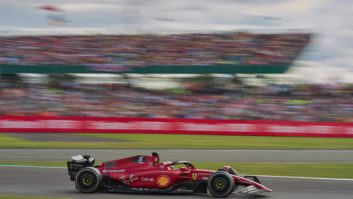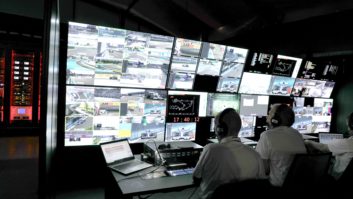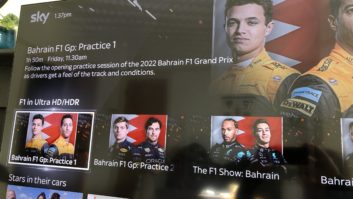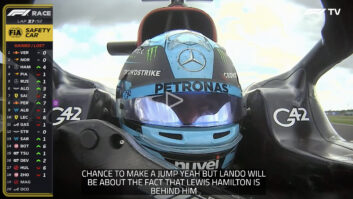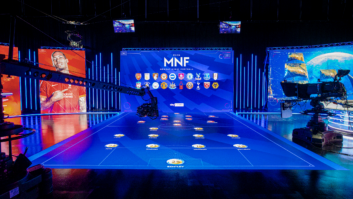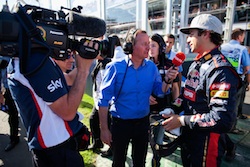
Philip Stevens learns how Sky Sports is producing its coverage of Formula One races for the home market – for a new dedicated 24/7 F1 channel.
Coverage of Formula One races has proved extremely popular to UK audiences. And that has meant negotiations for the contract to secure broadcasting rights have been intense. In fact, the rights to show Formula One races in the United Kingdom have changed hands several times over the past few years.
The BBC has been the exclusive broadcaster in the UK since 2009, but its contract with Formula One Management was due to expire after the 2013 season. However, under a new rights deal, both the BBC and Sky Sports will broadcast the sport in the UK between 2012 and 2018.
Sky Sports will show every race, qualifying session and practice live. BBC Sport will broadcast half the races live, as well as the qualifying sessions from those races. In addition, races screened by the BBC will be live on the BBC Sport website for UK users.
Until now, races and other sessions were shown as part of the regular channel programming of the broadcasters’ schedules, but to coincide with its new agreement, Sky Sports launched a dedicated F1 channel in March.
“We wanted to offer a product that is very important in our channel line-up,” explains Darren Long, Sky Sports’ director of operations. “Having a separate channel enables us to focus solely on the breadth of F1. It will enable us to spotlight the practice sessions and then continue the excitement all the way up to the races themselves.”
Long emphasises that this is a new business model that will allow Sky to show the race fans that the broadcaster is very serious about the way it approaches the sport. “By making it part of our normal HD entertainment package we are allowing fans of Formula One, who are not necessarily supporters of other sports, to enjoy the races and all that is associated with them without paying for a Sky Sports line up.”
When the qualifying sessions and the actual races are not taking place, the channel runs a number of features and promo material. Obviously, building the material that is needed for a dedicated channel will take time, but Long is happy to acknowledge the help he has received from the BBC with respect to archive footage. In fact, he says that the co-operation that has been achieved with the Corporation has been quite significant.
“I have been working closely with the BBC every step of the way, and looking at how we can continue that collaboration. And our long term commitment is to work in partnership with them and to offer our on-site resources. For instance, we are happy to provide our camera crews or feed material.”
Sky Sports will be using Studio 6 at its new facility at Osterley (see February issue of TVBEurope) for the new channel. This will host the F1 magazine programme on non-race weeks and provide presentation facilities as needed.
Included in the studio will be a Virtual Eye system that centres on a simulator of an F1 car. This enables the presenters to analyse closely a car’s performance during a race and to scrutinise tactics.
Location facilities
In addition, Sky has commissioned three portable studios that can be shipped to the race venues around the world. “These location studios are six metres by five metres with a ceiling height of six metres,” reveals Long. “Their design allows us to have a vista on what is going on outside the studio to let viewers experience the race atmosphere. Inside the studios, alongside the presentation set, there is an analysis spot with touchscreens and an interview area for guests.”
These studios are equipped with three Sony 1500 cameras. The production gallery is located within on-site portable cabins, and this is supplemented by four specially built technical ‘pods’. “One is an innovative sound pod that has been built by Gearhouse Broadcast and which really allows us to focus on the audio. Generally, TV compound areas are very close to the track where the ambient sound is just so high that to mix audio in the regular cabins is just about impossible. So we built a sound pod that is insulated as well as possible in order to concentrate on the 5.1 audio output.”
Another pod holds the XT servers that will enable Sky Sports to use five edit suites at each location for cutting package and other material. This pod also contains the Omneon MediaGrid shared storage systems that are linked to the Avid ISIS for media management.
“The edit pod will be the first to be put in place when we arrive on site at a race venue,” states Long. “We have a deal with the EBU, who will be distributing our content, which means our circuits are up and running even before we arrive on site.
“That allows our staff to become operational very quickly. In fact, we have a great number of circuits for material to be fed to Sky centre – and back to the venue – so there is never a shortage of material for the channel. These are fibre circuits that are operational 24 hours a day and we are not utilising satellites.”
Back at Sky Studios, a replica editing and storage system has been installed that allows material to be handled in a similar way to the location facility. Four Panasonic P2 cameras fitted with specialist radio links are used for track-side interviews and pits and paddock activities.
Although these cameras cannot be used for actual race coverage — broadcasters are required to take the signals from Formula One Management (FOM) — Long reports that Sky Sports has been given permission to use its P2s during practice sessions. “We are working with Broadcast Sports Inc (BSI) to provide a system that involves a broadcast frequency of seven gigs. This allows us to stay away from all the other radio traffic in the area. It does mean that we have to erect a few more antennas than usual as line-of-sight becomes very important on that frequency.”
Graphics for the race statistics originate from the FOM output, but Sky will supplement those as required with its own on-site Vizrt system.
With such a massive undertaking, what does Long feel was the greatest challenge in the project? “Without a doubt, logistics! Moving technical equipment – there’s about 17 tonnes involved – and then 10 tonnes of studio equipment, plus all the personnel is a huge activity.”
Summing up, Long says the project has involved every aspect of the overall Sky operation. “This is a truly multi-platform proposition and we will offer extensive and innovative coverage across mobile and tablet, online and via interactive TV. Ensuring that wherever our customers are they can watch and interact with our F1 coverage like never before.”
www1.skysports.com/formula1
www.formula1.com
www.virtualeye.tv
www.sony.co.uk
www.gearhousebroadcast.com
www.omneon.com
www.avid.com
www.broadcastsportsinc.com
www.panasonic.com
www.vizrt.com
www.scribblelive.com
